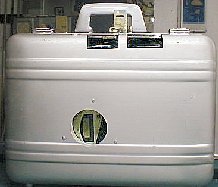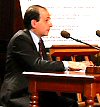 (212) 925-1365
19 Mercer Street, New York, NY
(212) 925-1365
19 Mercer Street, New York, NY
Jump to:
Cross-Exam Prep
Joint Testing
Calibrated Recordings
Courtroom Demonstrations
Expert Testimony
If Your Client Makes Noise
Violations
Lease Language
Site Evaluation
The best solution to any noise problem is to fix it, and this is most easily accomplished with the co-operation of all parties. It is cheaper, quicker and causes fewer problems in the future.
But...
...sometimes the parties simply cannot come to an agreement. When litigation begins, attorneys need more than just reliable measurements, they need savvy, experienced advice.
Read a recent Tesimonial Letter from an Attorney
How will you cross-examine the opposition's experts? Is there a way for your client to avoid a fine, even after they've gotten a violation? What are the relevant parts of the Code that pertain to the issues in question?
Many people imagine a sound level reading as a single number. "How many dBs was it?". The reality is more complicated. Different methods are appropriate for different situations, depending on the location, the source of the sound and the specific Code sections involved.
There are accepted procedures that must be followed in order to make accurate and appropriate measurements. If opposing experts have diverged from accepted procedure, you'll want to be prepared to question them about it. In a recent case, an opposing expert deviated from accepted practice in at least two different ways; would you have caught his errors? [transcript excerpts linked below]
The more you understand about the subtleties of noise and measurement techniques, the better armed you are for litigation. Our consultant, Alan Fierstein has a knack for explaining technical issues in terms that are understandable to the non-expert.
Having our consultant observe the tests made by an opposing expert can provide invaluable ammunition for your side's case.
Acoustilog has been a pioneer in the use of Calibrated Noise Recordings. Unlike the recordings most people are familiar with, ours are made with precision measurement microphones and the calibration procedure is saved right on the recording. This allows them to be used in ways that standard recordings cannot.
Please visit our Calibrated Recordings page.
In cases where the disturbance at issue is intermittent and there is no co-operation between the parties, clandestine testing is necessary. But it can be difficult to "catch" the noise in the standard way - measured in person by an acoustic consultant.  We have developed a Tamper-Proof Calibrated Recording System that can be left in the affected premises for an extended time. Your clients can turn the record function on and off when they hear the noise in question, but they cannot otherwise change any of the settings.
We have developed a Tamper-Proof Calibrated Recording System that can be left in the affected premises for an extended time. Your clients can turn the record function on and off when they hear the noise in question, but they cannot otherwise change any of the settings.
The system actually records sound starting 30 seconds before the client presses "Record", enabling them to catch even very short-lived sounds. Using a written log we ask the client to keep, we can measure and document the recorded disturbances. Depending on the number of channels used, the system can record up to 62 hours and can even be left unattended if the situation requires it.
Even if you could get a consultant to come over quickly enough to measure an unpredictable noise event, you would only have documented one occurrence. This is sometimes insufficient evidence. An defective elevator that clanks every time it passes the third floor can reasonably be expected to do so regularly. But a measurement of loud music taken in a residence that is located over a restaurant is vulnerable to the defense that the complainant has "cherry-picked" an unrepresentative event - "There was just that one loud party".
We know of one much-reported case in which the plaintiffs lost their suit against a restaurant because their consultant measured exactly twice - each time on New Year's Eve. The judge ruled that "One occasion - on New Year's Eve - does not a continuing, recurring nuisance make."
See: A Cautionary Tale: Pildes v. Restaurant Daniel
While there are specific Code limits on noise, it can be difficult for a Judge to imagine exactly what 63 dB at 125 Hz might sound like.
Effective courtroom testimony requires more than just having done the proper measurements.  A judge has to weigh the testimony of opposing experts, in an area in which his own expertise is likely limited. An expert who tries to puff up his opinions with impenetrable jargon is less likely to be effective than one who can explain his findings in plain terms. Alan Fierstein has years of successful experience doing just that.
A judge has to weigh the testimony of opposing experts, in an area in which his own expertise is likely limited. An expert who tries to puff up his opinions with impenetrable jargon is less likely to be effective than one who can explain his findings in plain terms. Alan Fierstein has years of successful experience doing just that.
Please visit our Expert Witness Testimony page which includes links to a number of specific decisions and cases.
The NYC Noise Code has language to protect residents from kinds of noise that the DEP does not yet measure. We do.
See DEP Meters
Firstly, we can make our own measurements. If the noise turns out to be within Code limits, our documentation can help your defense. If the noise is indeed in violation of Code, or perhaps of your client's lease, we can make detailed recommendations to fix the problem as cost-effectively as possible.
If your client has received a noise violation from the ECB or DEP, they must act right away. Further violations can lead to even larger fines and a shutdown of their equipment. See "Violations"
If your client is actually in violation of local codes, he will eventually have to do what it takes to curb the noise. But paying a fine is essentially money thrown away; money that might be better employed on remediation. Sometimes the DEP's measurements can be shown to have been made incorrectly, and a violation dismissed as a result. Ask us to review their findings.
If your client is a business that makes noise, such as a nightclub, a gym or a kennel, you'll need to make sure that they can operate within the limits of any lease language that addresses noise. We were involved in a case in which a gym was forced to close because they could not. This was good news for our client, the recording studio next door, but a disaster for the gym.
If your client has a special need for quiet, such as a recording studio, you may want to get lease language that will help protect them before they sink money into building out the facility.
For businesses that make noise, the choice of location is crucial.
See:
Pilot vs. Sutton
Before You Sign a Lease
Questions?
Please call us at:
212-925-1365
or write to us using our Contact Form.
Use the menu at left to access the rest of our site.
Back to Top
Copyright 2023 Acoustilog®, Inc.